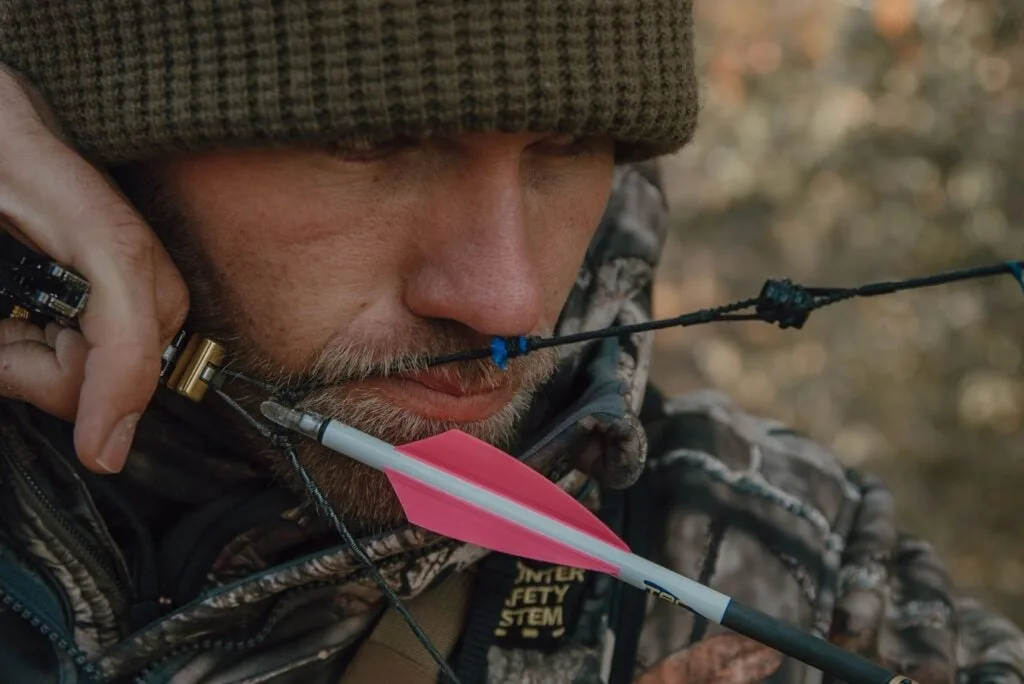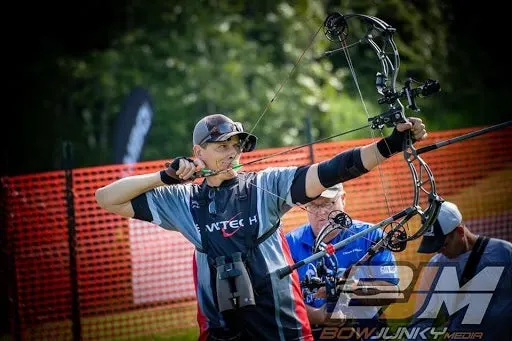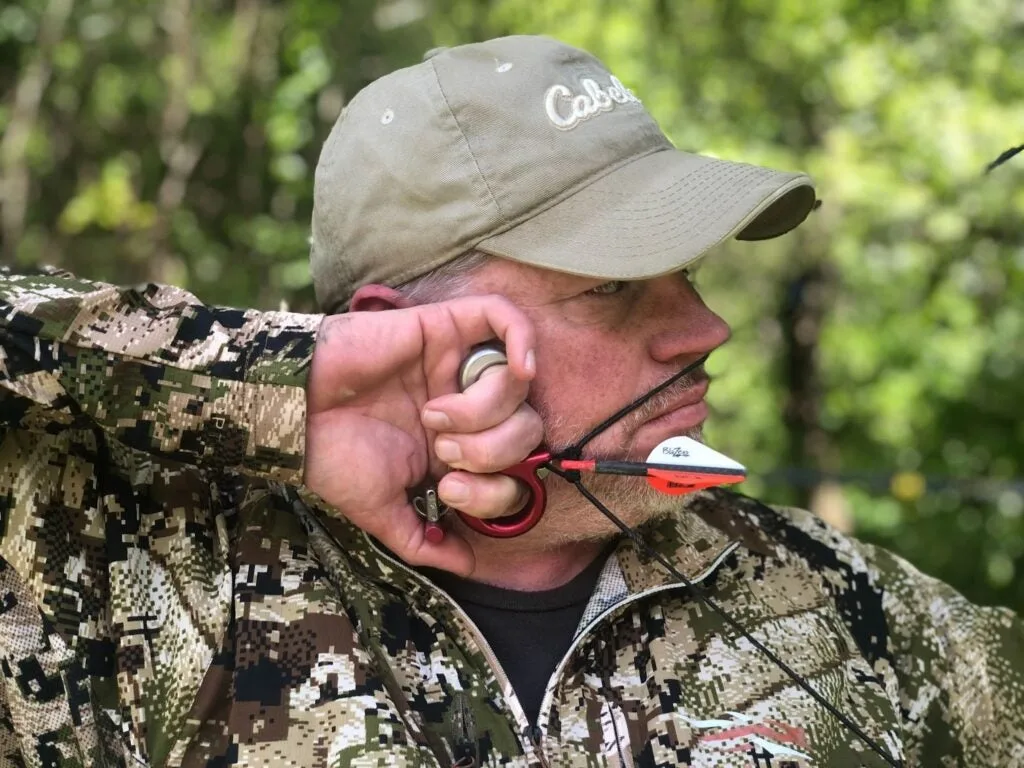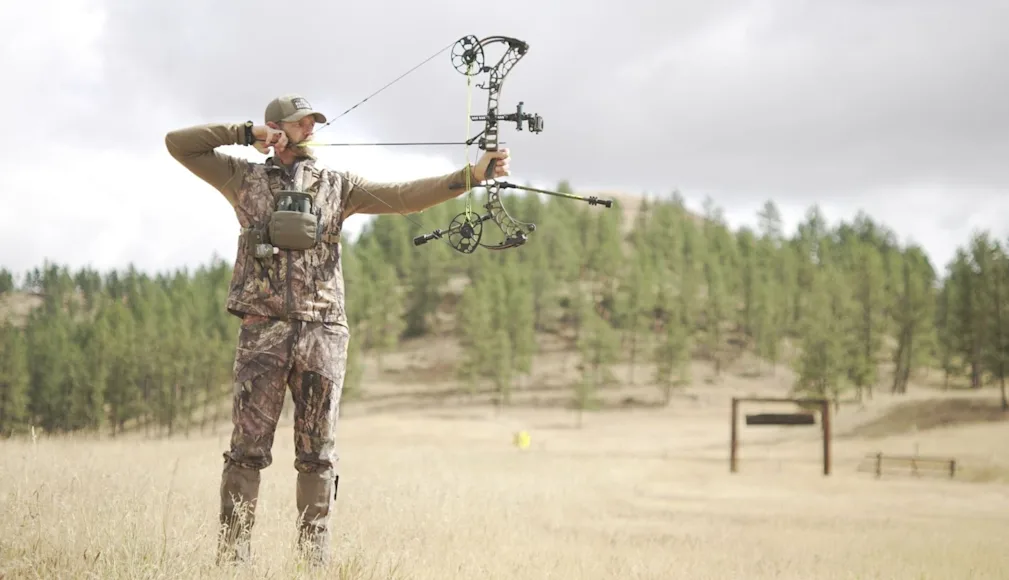_We may earn revenue from the products available on this page and participate in affiliate programs. Learn more ›
_
This should be so simple, right? You pull the string back, aim, and shoot. Well, the good news is that if you do everything right and you put your time in, learning how to shoot a compound bow like a pro can be that simple—eventually. But first you need to sort out a few nagging complications.
First and foremost is the fact that there is more than one way to shoot a modern bow. The vast majority of everyday bowhunters, for example, simply punch the trigger when the sight picture looks good. Most high-level 3D shooters, on the other hand, do not. Now here’s the key: Now matter what you’ve been told, you can learn how to shoot a bow really well either way. You just have to decide which way is right for you. And you have to nail down some fundamentals. So let’s begin there.
How to Shoot a Compound Bow: Getting Started

The Bear Cruzer G2 is a good beginner’s bow if you are just starting out. Bear Archery
First, I’m going to make some assumptions. (I know, but I’m going to do it anyway.) I’ll assume that you are shooting a reasonably modern bow set up with a peep, a D-loop, and a decent rest and sight, at the least. This can be a $400 compound bow for beginners
. Doesn’t matter for our purposes. What does matter is that the draw length and weight are right for you. If you’re not sure, watch this
or go to your local pro shop. I’ll also assume that you have the proper arrows and that you’re using a release aid, sometimes called a bow release, probably an index- (or caliper-) style if you’re a hunter.
Read Next: Compound Bow Buyer’s Guide
Now, if you’re new to this, partner up with a more experienced buddy or go to your pro shop and shoot at close range. Your first job is to just get comfortable with your bow and establish your anchor points and set your peep height. (Don’t worry, your buddy or your pro will know how to help you with this.) Once you’re feeling good with everything, it’s time to sight in and tune your bow. If you don’t know how to do that, here is your guide.
Okay. Now we are ready to discuss how to shoot a compound bow.
How to Shoot a Compound Bow with Proper Form

Levi Morgan, at the range, demonstrating perfect shooting form. Levi Morgan
You may have noticed that archers talk a lot about shooting form, and when they do, the idea often comes across as a sort of mystical state of being that you can only strive toward but never achieve. Well, it ain’t that. It’s just a handful of simple things, really. (The hard part is doing them all correctly on every shot, but that’s what practice is for.)
Here are the basic keys to developing proper archery form, taken from an interview I did with Levi Morgan, the best 3D competition shooter the world has ever known and a damn good hunter to boot.
1. Stand Steady
Set your feet perpendicular to the target about shoulder width apart, and then turn your toes out slightly for better stability. “Try standing this way on a piece of cardboard,” says Morgan. “Get your feet just right and then have someone trace them. Whenever you practice, put that cardboard down and stand in the outlined footprints. After a month you can ditch the cardboard, and you’ll take the exact same stance every time you address a target.”
2. Anchor Up

Morgan puts his release hand in the same place on his face every time and drops his nose on the string. Levi Morgan
Consistent anchor points are critical at full draw. Morgan uses three: First, he puts his release hand against his face in exactly the same spot on every shot. Second, he rests the tip of his nose on the string. Third, he holds the release in the very same way, shot after shot. “Not everyone thinks of the last one,” he says, “but if you change how you grip the release, it will affect your shooting.”
3. Relax Your Grip
Don’t grab the bow’s handle like a hammer. That introduces unwanted torque. Instead, rest the bow’s grip against the bony part of your palm’s heel, between the two flashy pads. “I favor the thumb side some,” says Morgan. “Otherwise the pads on either side can influence your grip inconsistently.” Lower your fingers safely under the shelf, but leave your hand relaxed as you shoot.
4. Keep It Straight
Form as straight a line as possible from your grip hand back to your lead shoulder, and keep that shoulder low and extended. “Don’t entirely lock out your bow arm, but don’t bend it much either,” Morgan says. You also want a straight line from the tip of the arrow all the way back to the point of your string-arm elbow. “It’s easy to put a kink in that line where your release meets your face, so try to keep that straight.”
5. Don’t Push and Pull
Conventional wisdom would have you push toward the target with your bow arm and pull away with your string arm at full draw. “That’s becoming old-school,“ says Morgan. He shoots static, meaning he pulls just hard enough to stay against the back wall. “Otherwise it’s too easy to push or pull a little harder from shot the shot, making the method difficult to repeat.“
[Note: We are skipping the actual shooting step for now, because there’s more than one method. Everything else basic form is pretty standard, though, no matter what your shooting style.]
6. End Naturally
After the shot, don’t exaggerate the follow through. Don’t consciously throw your string arm back after the release. “If you have correct form, proper follow through is just going to happen—along with better accuracy.”
How to Shoot a Compound Bow Using the Command-Style Method (Otherwise Known as Punching the Trigger)

Tim Ghillingham uses his command-style shooting method in a 3D shoot. Gold Tip Arrows Gold Tip Arrows
I mentioned earlier that the vast majority of everyday bowhunters shoot a bow by punching the trigger of an index release when the sight picture looks good—and the vast majority of us have been told that this is the wrong way to do it.
Well, it ain’t. And if you don’t believe me, believe another of the best 3D archers and hunters around. “Don’t let anyone tell you that punching is a negative,” says Gold Tip’s Tim Ghillingham, who has won multiple IBO 3D World Championships doing exactly that. “It can work really well in competition, and I think it’s the only way to shoot for hunting.”
If you don’t want to call it “punching,” do what Ghillingham does and call it “command-style” shooting. That way, when someone says, “Dude, you’re punching the trigger,” you can whip out that term and explain that what you are doing is deliberate and intentional and totally pro. Because it is, if you do it like Ghillingham. Here’s how.
1. Slow Down
To begin with, let’s assume you’re on the practice range, shooting at a small bull at just 10 or 15 yards. Now go ahead and draw then aim. “It’s not possible to hold the pin perfectly still on that mark, so concentrate on slowing the pin down,” says Gillingham. Lay your finger lightly on the trigger, focus on the middle of the dot, and fire the moment the pin passes over the center. “For me, the key to slowing the pin down is keeping tension on the rear of the shot—about 30 percent push and 70 percent pull.” Experiment until you get it just right.
2. Visualize Success
As you shoot at longer ranges, visualization becomes critical, says Gillingham. Before and after each shot, let your mind’s eye see a vivid picture of the pin moving slower, slower, then touching the center of the bull—and thunk, perfect shot. “If you consciously decide to shoot, you’ll anticipate the shot, which is the kiss of death. Trust that your body will perform what you’ve visualized, and the trigger will just go off when the sight picture is right. Master that, and you’ll start seeing a huge improvement.”
How to Shoot a Compound Bow Using a Surprise Release

The author uses a thumb release to make a surprise-type shot. Dave Hurteau
Unlike many hunters, the vast majority of competition 3D shooters use a surprise release of some sort. That is, they hold the pin steadily on target while tripping a mechanical release so slowly and gradually that the shot comes as a surprise. (This is just like many rifle shooters, who get on target and then slowly squeeze the trigger). For years, back tension was considered the surprise-release method for serious archers, but many top pros have gotten away from it, including Levi Morgan. Here are the key steps to his method.
1. Float the Pin
No one can hold a bow steadily enough while aiming to keep the sight pin perfectly centered on a distant target. So don’t try. “I watch the pin float over the target while I concentrate on the center,” says Morgan. “It’s amazing how much pin movement you can get away with and still make a good shot just by thinking about the middle of the bull.”
2. Relax and Concentrate on the Bull
At this point, a back-tension shooter would begin to “pull the bow apart,” using shoulder and back muscles to push forward with the bow arm and pull backward with the string arm. But Morgan just tries to relax and place all of his focus on aiming. “You can’t fully concentrate on two things at once when you’re shooting,” he says. “So I drill down on aiming and thinking about the center of the bull. Then I let the release just happen, almost automatically, through practice and repetition.”
3. Be Surprised
Morgan typically uses either a thumb or hinge release, but the principle is the same with the index-style. “Slowly squeeze the trigger, or press the thumb button, or rotate your hand until the release goes off. It should be a surprise every time.“ If you’re a hunter who uses an index release and you want to shoot this way, do yourself a favor and at least try a thumb release. In my experience, and most everyone else’s, this makes it easier to perform a repeatable surprise release.
How to Shoot a Compound Bow Using Back Tension

The Carter Evolution 20 is a true tension-activated release, meaning it will only fire via back tension. Carter
Back tension may somewhat be falling out of favor, but for decades it was gospel for serious shooters and was the method used by virtually every pro that ever stood on a podium. So, it obviously works.
Plenty of top 3D shooters still use this method and swear by it. In a nutshell, back tension is squeezing your shoulders together behind you, using your back muscles, until the release fires. It feels like you are pulling the bow apart, and instead of using small muscles, like a finger tip, to trip the release, you are using big muscles, which are less twitchy. It is possible to shoot back tension using an index release, by making a fixed hook of your index finger, but most shooters use either a thumb or back-tension release (hinge or true tension-style) for this method.
Learning to shoot with back tension isn’t especially easy, and using the method in a hunting situation is something many shooters described as “unthinkable,” but if you’re serious about competition shooting, it may be right for you. Here’s a three-week plan for learning the method.
1. Get Comfortable
During week one, stand just a few feet in front of a target. Come to full draw and settle into your anchor points. Now close your eyes and begin squeezing your back muscles, or shoulder blades, together, drawing your release elbow rearward. This motion should trip the release (no matter what type), and the shot should come as a surprise. Do this 15 to 20 times a day to get used to the basic motion. It will seem really weird at first, but you’ll get it.
2. Make Muscle Memory
Start each session of week two with the routine above, then step back 15 or 20 yards and shoot 30 to 40 arrows with both eyes open. Then finish the session with 15 to 20 more close-up, eyes-closed shots, concentrating on the feeling of tripping the trigger with back tension.
3. Relax and Focus
Start shooting at 20 and 30 yards. For each shot, take a deep breath and focus on burning the pin into the target. Then just let your back muscles take over to fire the shot. If you get off track, go back to the point-blank, eyes-close drill as a refresher. Soon, you’ll be ready to practice as far out as you want.
How to Choose a Compound Bow-Shooting Method and Perfect It
There, that’s how to shoot a compound bow. I told you it was easy.
Seriously, you’re almost there. You have just a couple more things to do before this all becomes second nature. First, you have to choose the method that is right for you.
If your main goal is to compete at a high level, you should definitely try back tension. Otherwise, you can probably just rule it out for now. If, like most of us, you are primarily a hunter who may shoot a little 3D here and there, what you really need to do is figure out whether or not you want to have a surprise release. Now, you may be thinking, Of course, I want a surprise release, given that 90 percent of the top shooters do it that way and because everyone says punching the trigger is bad.
Forget that and trust me. Try it both ways. There’s a lot to be said for command-style shooting in the field, when adrenaline is high and you may have only a split second to take the shot. More important, a surprise release promotes target panic in some folks, which is something you really don’t need in the woods.
Having shot both ways extensively myself, I’ve found that I shoot just a little bit better at longer distances using a thumb-style release and a surprise shot. But here’s the thing: This method brings on a touch of target panic for me. With command-style, using an index release, I don’t feel any panic at all. And inside 50 yards or so, I shoot just as well, or very close to it. So, as a hunter, I’ve settled on command-style.
You need to figure this out for yourself. Then you need to practice until your chosen method feels natural. Then, finally, shooting a bow—and shooting it really well—becomes so simple. You pull the string back, aim, and shoot.






